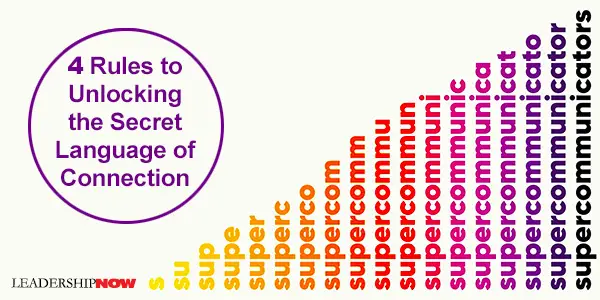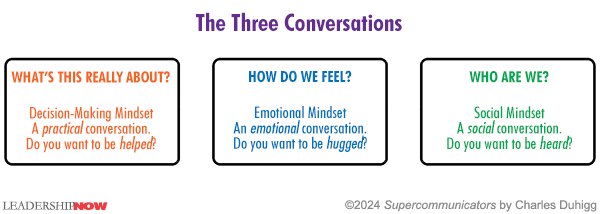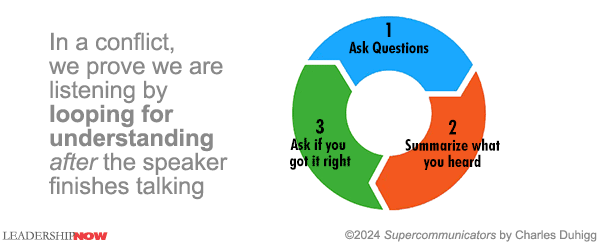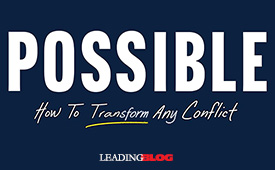
4 Rules to Unlocking the Secret Language of Connection

THE GOAL of any communication is to connect. Some people are supercommunicators. That is, as they talk, they align with the person they are speaking with, constantly adjusting how they communicated in order to match their companions.
In Supercommunicators, Charles Duhigg explores how we communicate and connect. He explains why our communication sometimes goes awry and what we can do to make it better. “Anyone can become a supercommunicator—and, in fact, many of us already are, if we learn to unlock our instincts.”
To begin, we need to understand that many discussions are actually three different conversations, and if we want to connect, we need to be “engaged in the same kind of conversation, at the same time” as the person we are communicating with.
There are practical, decision-making conversations that focus on What’s This Really About? There are emotional conversations, which ask How Do We Feel? And there are social conversations that explore Who Are We? We are often moving in and out of all conversations as a dialogue unfolds. However, if we aren’t having the same kind of conversation as our partners, at the same moment, we’re unlikely to connect with each other.
With that in mind, we can see that the most meaningful conversations should be characterized as learning conversations. We want to learn how others see the world and help them to understand how we see the world too. Learning conversations are based on the following four rules:
Rule One: Pay Attention to What Kind of Conversation Is Occurring
We miscommunicate when we are having different kinds of conversations. “Effective communication requires recognizing what kind of conversation is occurring, and then matching each other.” When we connect with others, it is because our brains have come into a kind of alignment. When we dominate a conversation, we make it difficult for others to sync up; they become pushed into their own thoughts.

Effective communication requires recognizing what kind of conversation is occurring, and then matching each other.
Characteristics of Supercommunicators:
- They tend to ask ten to twenty times as many questions
- They constantly adjust how they communicated in order to match their partner
Rule Two: Share Your Goals and Ask What Others Are Seeking
Every meaningful conversation begins as a negotiation about what this conversation is to achieve and how it’s going to go or how we’ll make choices together.
Matching is understanding someone’s mindset—what kind of logic they find persuasive, what tone and approach makes sense to them—and then speaking their language. And it requires explaining clearly how we, ourselves, are thinking and making choices, so that others can match us in return.
Rule Three: Ask About Others’ Feelings, And Share Your Own
Emotions are a part of nearly all conversations if we choose to acknowledge it. When we do acknowledge it—their emotion, their vulnerability—and are vulnerable in return, we build trust, understanding, and connection. You begin by asking someone how they feel about their life as opposed to the facts of their life.
Margaret Clark, the Yale psychologist, said, “The best listeners aren’t just listening. They’re triggering emotions by asking questions, expressing their own emotions, doing things that prompt the other person to say something real.”
Laughter is one of proving that we hear how someone feels. We exhibit emotional intelligence by showing people that we’ve heard their emotions-and the way we do that is by noticing, and matching, their mood and energy. When we match or acknowledge another person’s mood and energy, we show them that we want to understand their emotional life. It’s a form of generosity that becomes empathy. It makes it easier to discuss How Do We Feel?
Acknowledging emotions is critical when dealing with conflict. If you don’t get to the emotions, you’ll never know what the fight is actually about. “This is the real reason why so many conflicts persist: Not because of a lack of solutions or because people are unwilling to compromise, but because combatants don’t understand why they are fighting in the first place. They haven’t discussed the deeper topics—the emotional issues—that are inflaming the dispute.”

Lessons from Martial Conflict
Nearly all couples fight from time to time. And whether happy or unhappy, they tend to fight about the same things. For the most part it comes down to control issues. Consider these findings:
Researchers noticed that many divorces happened after major life changes, in part because these changes had triggered a sense of losing control. It might be an illness—control over our health—or a big upheaval as retirement or kids leaving for college, which makes the future seem less predictable. These shifts made people exhausted, lonely, anxious, as if they had lost agency over their days and bodies and minds.
But happy and unhappy couples, the scientists saw, sought to assert control in very different ways. Among unhappy couples, the impulse for control often expressed itself as an attempt to control the other person.
Among happy couples, however, the desire for control emerged quite differently. Rather than trying to control the other person, happy couples tended to focus, instead, on controlling themselves, their environment, and the conflict itself. Happy couples, for instance, spent a lot of time controlling their own emotions. Happy couples also focused on controlling their environment. Finally, happy couples seemed to concentrate more on controlling the boundaries of the conflict itself.
One advantage of focusing on these three things-controlling oneself, the environment, and the boundaries of the conflict—is that it allowed happy spouses to find things they could control together.
Lesson: Share control.
Good thought: “It’s a complicated world, you know? You need friends who are different if you want to figure it out?
Rule Four: Explore If Identities Are Important to This Discussion
Our social identities shape how we speak and how we hear. In crucial conversations, we often get locked in on one identity. But we possess multiple identities and find identities we share.
In a Who Are We? conversation, we sometimes latch onto a single identity: I am your parent or I am the teacher or I am the boss. In doing so, though, we hobble ourselves, because we start to see the world only through that one lens. We forget that we are all complex and that, if we were thinking like parents instead of doctors, we might also ask skeptical questions about the drugs a stranger wants to inject into our kids. We might remember that asking questions is what good parents are supposed to do.
So, in a Who Are We? conversation, we need to begin by drawing out our conversational partners’ multiple identities. Second. We need to put everyone on equal footing. “Don’t offer unsolicited advice or trumpet your wealth or connections. Seek out topics where everyone has some experience and knowledge, or everyone is a novice.” Finally, look for similarities and create new groups by building on existing identities.

![]()
Posted by Michael McKinney at 12:09 PM
Permalink
| Comments (0)
| This post is about Communication







